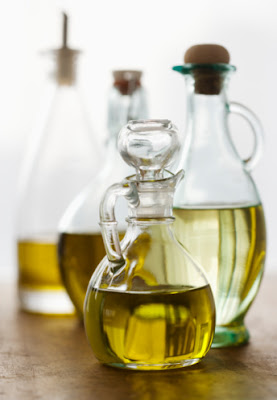I couldn’t cook without olive oil. It is probably the single most important ingredient I use in my kitchen. It enhances the flavors of nearly all of my vegetable dishes and salads as well as soups, and even drizzled over pasta or fish.
Butter has its place in my cooking-lending richness and velvety smoothness to dishes, but more often than not I will reach for a bottle of olive oil that is always close at hand. It is of course better for you than butter, but as always taste to me is the most important thing, and there isn’t quite anything as lovely as a rich, fruity olive oil.
The first oils are extracted purely by cold press where neither heat nor chemicals are used in the extraction process; the oil is then allowed to settle and then filtered. Extra virgin olive oil is obtained from the first pressing of the olives. It can be robust with a round rich nutty or even grassy taste. Other varieties can be fruity, buttery or even spicy with a distinctive lingering peppery finish. Different varieties have their own unique flavor. The color can range from deep murky olive green to pale and golden and every shade in between. The price can also range from modest to extremely expensive.
I usually have two grades on hand; a less expensive, neutral flavored olive oil for cooking and I tend to save the best extra virgin olive oil for dishes that I feel showcase the virtues of a full flavored oil.
It’s good to try different olive oils to find those you like and fit within your budget. Look for labels indicating that the oil has been bottled on the estate on which the olives have been grown, hand-picked and pressed. This is usually a sign of a superior quality.
Although a good quality olive oil is expensive compared to other ingredients, there’s no comparing how it transforms the simplest foods.
Finally, olive oil should be treated with respect and care. It does not respond well to heat, light or when exposed to air all of which will cause it to oxidize.
Here are some of my favorite Olive Oils:
Olio Novello Olive Oil
Distinguished by its cloudy golden hue with a distinctive green tint, this “new” olive oil is cold-pressed from the first olives of the season. From the Lucero family, producers of olive oil for three generations, the unfiltered blend of 100% California-grown, hand-harvested Servillano, Mission
Ravida Organic Extra Virgin Olive Oil
This award-winning certified organic extra-virgin olive oil is produced by the Ravida family on their estate in Menfi , Sicily
Marques De Griñon Extra Virgin Olive Oil
This world-renowned olive oil represents the very finest that Spain Toledo del Fraile is a 100% estate-bottled extra-virgin olive oil from the Montes de Toledo region of Spain
~Shannon










